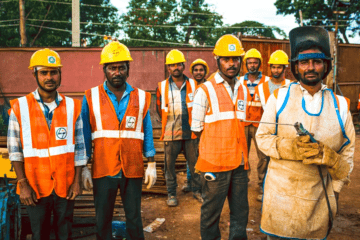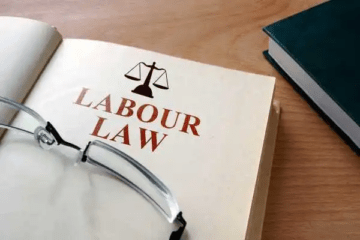
This article is written by Gauri Singh of 7th Semester of BA LLB (Hons.) of Shri Ramswaroop Memorial University
Abstract
There rights has been recognised by the act. But act has prohibited the resort of Strike & lockout in certain circumstances and the prohibition is based on public policy.
Section 22 deals with prohibition of Strike and lockout. For going on strike and lockout they required to fulfill certain condition.
According to section 22 (1) for going on strike
1 Notice should be given to the employer in prescribed manner.
2 The day on which notice is given then within 6 weeks strike would be take place 3 14 days have expired after such notice.
The right to strike and lockout represents a fundamental aspect of labor relations serving as a mechanism for employees and employers to assert their respective interests in the workplace. This abstract explores the concept of the right to strike and lockout examining its significance legal frameworks, and the delicate balance it strives to achieve between protecting workers’ rights and maintaining economic stability.
However the exercise of the right to strike and lockout is not without its challenges. Balancing the rights of workers to engage in collective action with the need to ensure economic stability and minimize disruptions poses a constant dilemma. Legal frameworks play a crucial role in determining the scope and limitations of these rights often guided by international labor standards national laws and collective bargaining agreements.
The abstract further delves into the potential consequences of strikes and lockouts. While they can effectively bring attention to labor issues and drive negotiations, prolonged or widespread disruptions may have adverse effects on businesses, economies, and the overall welfare of society. Maintaining a delicate equilibrium between labor rights and economic stability becomes imperative for policymakers often leading to intricate debates on the extent and regulation of these rights.
Moreover technological advancements evolving employment patterns and globalization have brought new dimensions to the right to strike and lockout. The rise of the gig economy remote work arrangements and cross-border labor movements pose challenges to traditional labor regulations, necessitating adaptations to ensure workers’ rights are protected in an ever-changing work landscape.
KEYWORDS:
Rights, Act, Strike, Lockout, Prohibition, Public Policy, Section 22, Notice, Employer, Labour Relations, Collective action, Economic Stability, Disruptions, Consequences, Labour Issues, Negotiations, Worker’s Rights, Labour regulations, Technological Advancements, Gig Economy, Remote Work, Cross-Border Labour Movements, Minimum Wages, Salary, Incentive issues, Company policies, Hours of work, Interval timing, Holidays, Leaves with pay, Bonus, Provident fund, Hunger Strike, Economic Strike, Illegal Strike, Legal Strike, Lockout, Employer’s actions, Labour Disputes, Case Law, Supreme court of India, Constitutional Validity, Freedom of Association, Good Faith, Legitimate Reasons, Property and Business Interests, Punishment, Harassment, Right to Livelihood, Fundamental Right, Public Footpaths and Streets, Peaceful strikes, Working Conditions, Bona Fide, Unfair Labour Practices, Malicious Intent, Victimizing Employees.
Introduction
Strike in terms of dropping our of work by any number of workers employed in the particular industry with an aim of creating pressure on the employers to accept their demand relating to pay scale, working condition, trade practice and so on.
A strike is a situation in which the worker stooping or denying to resume work. The relationship between the employer & employes continue to exist when the dispute is resolved.
Cause of Strike
1 Dispute relating to minimum wages.
2 Salary & incentive issues.
3 Dissatisfaction with the polices of the company.
4 Hour of work & intervals timing.
5 Holidays & leaves with pay.
6 Bonus provident fund.
Type of strike
1 Hunger strike – Strike in which the employees go on fasting at the residence of the employer to force him/her redress their grievances is called hunger strike.
2 Economic Strike – Economic strike is the stopping of work by the labour with an aim of imposing their economic demand like wages & bonus.
When Strike is Illegal.
1 When Strike is commenced in public utility service, contravention of the provision of section 22.
2 When strike is made in the industrial establishment in contravention of section 23.
3 If the strike is made violation of order of appropriate government.
When Strike is Legal
1 If there is no violation of any provision of the act at the time of commencement of the strike.
2 If it is not prohibited by any order of government.
3 If the strike is made when employer has declared lockout.
Lockout
1 There is an Element of demand for which the place of employment is locked out or closed.
2 There is an intention to Re-employ the worker if they accept the demand
A lockout occurs when an employer prevents employees from entering the workplace and doing their jobs. It is typically a defensive action taken by the employer during a labor dispute or as a preemptive measure to gain an advantage in negotiations.
During lockout employees are not allowed to work and may be denied access to the workplace. The employer may close down the business temporarily or hire replacement workers to perform the tasks usually done by the locked-out employees. The goal of a lockout is to put pressure on the employees or their union to agree to certain conditions or concessions put forth by the employer.
Lockouts can happen for various reasons such as disagreements over wages benefits working conditions, or the terms of a collective bargaining agreement. They are a strategy used by employers to exert leverage in negotiations or to send a message to employees and their union.
It’s important to note that a lockout is different from a strike. In a strike employee voluntarily refuse to work to achieve their demands, while in a lockout, employees are prevented from working by the employer. Both lockouts and strikes are tactics used during labor disputes to advance the interests of the respective parties involved.
Recent Developments
The right to strike and lockout refers to the ability of workers and employers, respectively, to take industrial action during labor disputes. Strikes are typically initiated by workers to put pressure on employers to meet their demands, while lockouts are actions taken by employers to prevent employees from working until a labor dispute is resolved.
Historically the right to strike and lockout has been recognized and protected by various international labor standards, including conventions of the International Labor Organization (ILO). These conventions acknowledge the importance of collective bargaining and provide guidelines for both workers and employers to engage in peaceful negotiations and resolve disputes.
In recent years, developments related to the right to strike and lockout have varied across different countries and regions. Labor laws and regulations governing industrial action can differ significantly depending on national or regional legislation and the political climate.
It is important to note that labor relations are dynamic, and changes in labor laws court decisions, or societal attitudes can impact the right to strike and lockout. Additionally, the COVID-19 pandemic has presented unique challenges for workers and employers, potentially influencing the exercise of these rights.
To obtain information on recent developments specific to the right to strike and lockout I recommend consulting reliable and up-to-date sources such as labor law publications news outlets and legal databases that cover labor-related matters. In recent years the right to strike and lockout has faced new challenges due to evolving economic and technological landscapes. Globalization, automation, and the gig economy have raised questions about the scope and applicability of traditional labor laws. The emergence of online platforms and digital marketplaces has blurred the lines between traditional employers and independent contractors necessitating a reevaluation of the right to strike and lockout in these contexts.
Case laws
1. Case Law on Right to Strike: National Union of Commercial Workers v. P. R. Ramakrishnan & Ors (1961)
In this case, the Supreme Court of India upheld the constitutional validity of the right to strike as an essential element of the freedom of association under Article 19(1)(c) of the Indian Constitution. The court ruled that the right to strike is not an absolute right but a qualified one, subject to reasonable restrictions in the interest of public order and public morality.
2. Case Law on Lockout: Management of Dimakuchi Tea Estate v. Their Workmen (1958)
In this case, the Supreme Court of India addressed the legality of a lockout. The court held that the employer’s right to lockout is recognized under the Industrial Disputes Act, 1947, but it must be exercised in good faith and for legitimate reasons such as protecting the property or business interests of the employer. The court emphasized that a lockout cannot be used as a weapon to punish or harass the workers.
3. Case Law on Right to Strike: Olga Tellis & Ors. v. Bombay Municipal Corporation & Ors. (1985)
In this landmark case, the Supreme Court of India acknowledged the right to livelihood as a fundamental right under Article 21 of the Indian Constitution. The court recognized the right of pavement dwellers and slum dwellers to carry on their legitimate trade or occupation on public footpaths and streets. The judgment also affirmed the right to strike, stating that peaceful strikes are a legitimate means for workers to claim their rights and improve their working conditions.
4. Case Law on Lockout: A.P. Electricity Board & Anr. v. A. V. Raghavamma & Ors. (1984)
In this case, the Supreme Court of India dealt with the legality of a lockout declared by the employer. The court held that a lockout could be justified if it is bona fide and the management genuinely believes that it is necessary to protect the interest of the industry. However the court also emphasized that a lockout should not be used as a tool for unfair labor practices and should not be declared with malicious intent or with the sole purpose of victimizing the employees.
Conclusion
The right to strike and lockout represents crucial aspects of labor relations and industrial disputes. These rights play a significant role in balancing the power dynamics between employers and employees ensuring the protection of their respective interests.
The right to strike allows workers to collectively withhold their labor as a means to assert their demands and improve their working conditions. It is often seen as an essential tool for workers to exercise their freedom of association and collective bargaining rights. However the right to strike is not absolute and is subject to reasonable restrictions in the interest of public order and public morality.
On the other hand the right to lockout provides employers with a means to protect their property or business interests during labor disputes. It allows employers to suspend work temporarily, effectively preventing employees from working and receiving their wages. However like the right to strike the right to lockout is subject to certain conditions such as being exercised in good faith and not being used to punish or harass workers.
Balancing these rights can be challenging, and the courts and legislatures in different jurisdictions have taken various approaches to strike a fair balance between the interests of employers employees and the public. The specific legal frameworks and case laws governing the right to strike and lockout can vary significantly from country to country.
References
- https://www.thehindu.com/opinion/op-ed/indias-deceptive-
- https://www.legalserviceindia.com/articles/thyg.htm
- https://lawaditya.com/strike-and-lockout.html
- https://en.wikipedia.org/wiki/Constitution_of_India




0 Comments